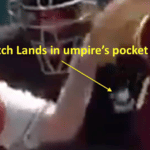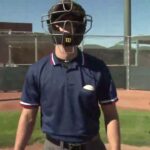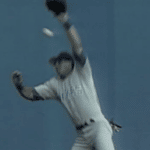NCAA 8-3 Entitled to Bases
Entitled to Bases
SECTION 3. The base runner shall be entitled to an unoccupied base if the individual touches it before being put out. The base runner is entitled to this base until put out or the individual may be advanced one or more bases under the following conditions:
a. If forced to vacate the base because of a following runner;
Note: With two outs, if a runner is awarded home but does not touch the plate before a following runner is put out for the third out, the run scores unless the batter-runner was declared out before reaching first base or any other runner was declared out before reaching the base to which he was forced.
b. If forced to vacate the base because the batter was awarded that base;
c. If the batter hits a fair ball that touches another base runner or an umpire before it has been touched by or has passed a fielder, providing the runner is forced to advance;
d. If the umpire calls a balk;
e. If obstruction by a fielder is committed:
1) Against a runner on which a play is being made;
PENALTY—The umpire shall point and call “That’s obstruction.” The ball is dead immediately. All runners shall be awarded the bases they would have reached had there been no obstruction.
Note: On a play at any base, the defensive player must clearly have possession of the throw before blocking the base with any part of the defensive player’s body. The umpire will call, “time, that’s obstruction.” The ball is dead immediately, and the runner being played on is awarded one base beyond the last base he had attained before the obstruction.
2) Against a runner on which a play is NOT being made;
PENALTY—The umpire shall point and loudly call “That’s obstruction.” The ball is NOT dead. The umpire shall allow the play to continue until all play has ceased, then call “time” and impose any penalties that will nullify the act of obstruction. Time shall not be called until all action has stopped and no further play is possible. The crew may confer in order to determine what a reasonable award should be had obstruction not occurred.
This second type of obstruction deals with the runner who is obstructed while no play is being made on him. Here are examples of this type of obstruction but are not all inclusive:
a) B/R is obstructed when he is rounding first base while the ball is in the outfield.
b) B/R is obstructed before reaching first on a ball hit to the outfield.
c) Runner steals and the catcher’s throw is wild and goes into the outfield and the base runner is obstructed while the ball is loose in the outfield.
d) Runner is obstructed while rounding third base on a hit to the outfield.
e) Any other example where no play is being made directly on the runner at the moment he is obstructed. Note: If a runner is obstructed under this second section of the obstruction rule, play shall continue until its completion, even if it results in a play being made on the previously obstructed runner. If the play results in that runner being tagged out before he reaches the base he would have been awarded, the umpire shall call “Time” at the moment the runner is tagged out. The umpire shall then impose such penalties that would nullify the obstruction.
f. Visual obstruction by a defensive player may be called if a fielder interferes intentionally with a base runner’s opportunity to see the ball on a defensive play.
PENALTY for f.—The umpire shall point and call “That’s obstruction.” The umpire shall let the play continue until all play has ceased, call time and award any bases that are justified in Rule 2. If a runner(s) advances beyond what the umpire would have granted and is put out, the runner(s) is out. The offender’s team shall be warned, and a second offense by that team shall result in the ejection of the offending player because of an unsportsmanlike act.
g. If a fielder intentionally touches a fair ball with a cap, glove, mask, helmet or any part of the uniform while detached from its proper place on the body, the runners are awarded bases which shall be determined by where the runners were at the time of the illegal touching. The call is a delayed dead ball and the runners may advance further at their own risk.
1) If it is a fair batted ball or foul ball with a chance of becoming fair, the individual shall be entitled to three bases.
2) If it is a thrown ball, the individual shall be entitled to two bases.
3) If it is a pitch, the individual shall be entitled to one base. The bases to be awarded shall be determined by where the runners were at the time of the touch. In all cases, the runners may advance further at their own risk.
4) The call is a delayed dead ball. Any attempt to advance beyond those bases that would be awarded is at the runner’s own risk.
5) If it is a foul ball that has no chance of becoming fair, it shall be ruled foul and there is no penalty.
h. If a fair ball goes over the fence in flight or is prevented from going over by being touched by a spectator or by a fielder’s detached equipment, all runners, including the batter, are entitled to score;
Note: If a batted ball hits the top of the fence while in fair territory and then bounces over the fence, it is a home run.
i. If a thrown or pitched ball strikes an umpire, the ball is in play and the base runner or runners are entitled to all the bases they can make;
j. If a thrown ball strikes a base coach on foul ground, the ball is in play. If the coach interfered intentionally with such a thrown ball, the runner is out and any other runners must return to the last base touched;
k. Each runner is awarded one base if a pitch or any throw (e.g., a pick-off attempt) by the pitcher from a pitching position on the pitching rubber goes into the stands, bench or other dead-ball territory, is intentionally touched by a spectator or lodges in an umpire’s or catcher’s equipment other than a glove;
l. If a fair batted or thrown ball becomes lodged in a player’s uniform, the ball shall be declared dead and bases awarded at the umpire’s discretion;
m. For fields with fences, if a fielder legally catches a batted ball, and then jumps over or falls over or through the fence and retains the ball, the batter is out and the ball becomes dead. All runners advance one base. If a fair ball is dropped outside the fence, it becomes a home run. This same dead-ball ruling applies to fly balls into any deadball areas;
n. When a spectator or any other individual interferes intentionally with any thrown or batted ball, the ball is dead at the moment of interference and the umpire shall impose such penalties as will nullify the act of interference (see 6-4-a);
o. Each runner is entitled to two bases:
1) If a fair ball bounces over or passes through a fence, unless local ground rules stipulate otherwise (see 4-5).
2) If a fair ball bounces or is deflected into foul territory outside the playing field and goes into the stands or spectator area; or if it goes through or under a field fence, through or under a scoreboard or through or under shrubbery or vines on the fence; or if it sticks in such fence, scoreboard, shrubbery or vines, or goes into a deadball area such as a bench or bullpen area or behind a field tarp per local ground rules.
3) If a live thrown ball goes into the stands or dead-ball area, spectators or a players’ bench, lodges in the equipment of an umpire, or sticks in the fence, shrubbery, etc., and provided it is not thrown by a pitcher from the pitching rubber, the ball is dead.
Note 1: If the thrown ball is the first play by an infielder, the position of the runners at the time of the pitch shall determine the awarding of bases. Exception—If all runners, including the batter-runner, advance one base before the time of the throw (meaning the release of the ball), the bases awarded shall be measured from the time of the throw, not the time of the pitch. If the throw is made by an outfielder, award bases to all runners from the time of the throw.
Note 2: For the purpose of this rule, the act of fielding the ball or a faked or feinted throw is not considered a play; a “play” must be a legitimate attempt by a fielder to retire a runner.
Note 3: Any runner who reaches or passes the base the runner would have received on an award is considered to have advanced to that base even if subsequently declared out for not touching the base.
4) If, during an attempt to field a wild pitch, passed ball, or wild throw on a pick-off attempt, the catcher or any other fielder deflects the ball into a dead-ball territory, the runner(s) shall be awarded two bases from the bases occupied at the time of the pitch.
Note 1: If the ball has stopped rolling or it is clear that the ball will not roll into dead ball territory and a new impetus is applied to the ball by a defensive player, the awards are two bases from the time of the act.
Note 2: When multiple runners are to be awarded two bases, the following runner will be awarded only one base if the award of two bases would place him at the same base as a preceding runner.
5) If any batted or thrown ball intentionally is kicked, thrown, deflected or carried into a dead-ball territory, the runner(s) shall be awarded two bases from the time of the act; or
p. If, on an attempted squeeze play or steal of home plate, the catcher steps on or in front of home plate without possession of the ball or touches the batter or the bat, the pitcher shall be charged with a balk and the catcher with interference.
PENALTY—The ball becomes dead, the batter shall be awarded first base on the interference, the run scores and all other runners advance one base.
q. If any base is dislodged from its position during a play, a runner shall be considered as touching or occupying the base if the runner touches or occupies the point originally marked by the dislodged base.







